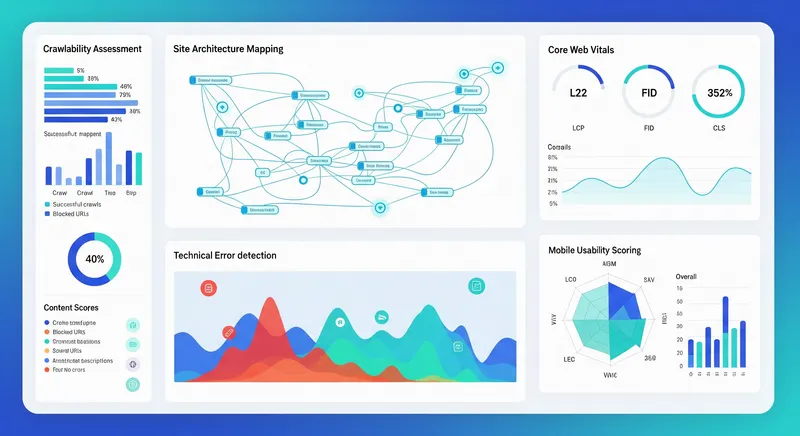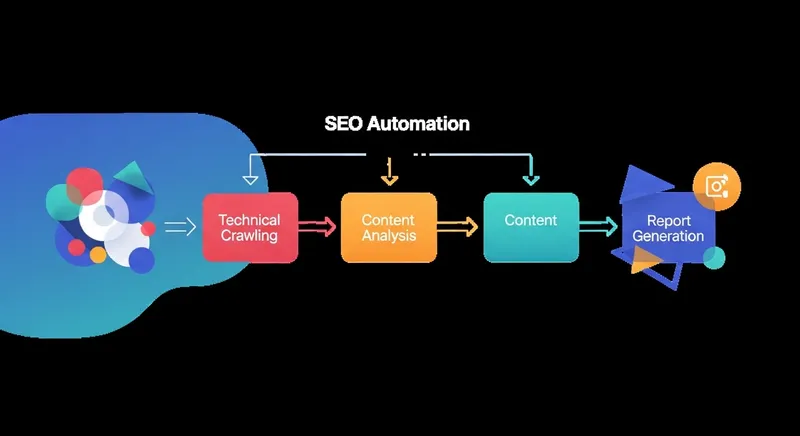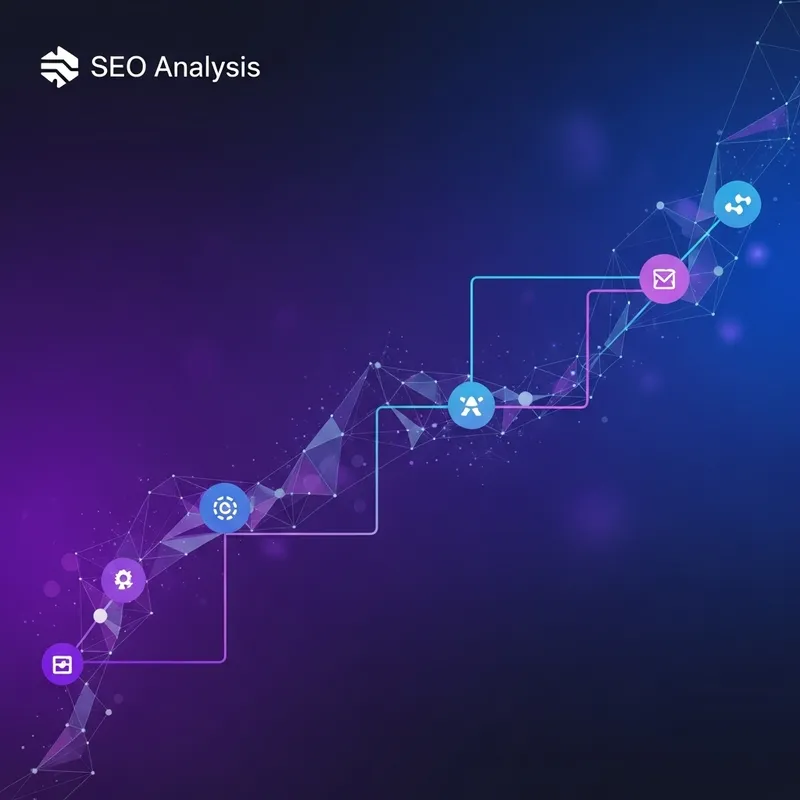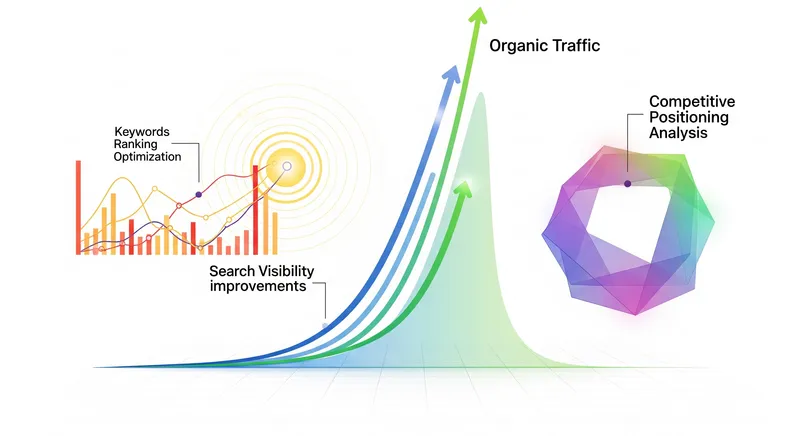Zachary Forbes
SEO Optimization Specialist

What are Automated SEO Audits?
Automated SEO audits leverage Artificial Intelligence to rapidly analyze website technical health, content performance, and ranking factors. Unlike manual audits taking weeks, AI-driven platforms crawl thousands of pages in minutes.
Businesses using AI for automation
For keyword research and meta-tag optimization (HubSpot, 2024)
Understanding the Market Shift
The $4.97 billion AI SEO market projection isn't just a number—it represents a fundamental shift in how businesses approach search optimization. Companies still relying on manual audits are essentially competing with one hand tied behind their back. The 67% of businesses already using AI for SEO aren't early adopters anymore; they're the new standard.
For business owners, this data reveals a critical decision point: adopt automated auditing now while it's still a competitive advantage, or wait until it becomes table stakes and you're playing catch-up. The 10.5% CAGR suggests this window is closing rapidly.
Most importantly, that 75% automation rate for keyword research and meta-tag optimization shows where the industry is heading. These aren't experimental technologies—they're proven, profitable tools that your competitors are likely already using to outrank you.
Key Benefits of Automated SEO Audits
Dramatic Time Savings

Enhanced Accuracy
Scalable Analysis
Handle audits for large websites or multiple sites simultaneously, ensuring consistent and standardized approach across all digital properties.
What This Means for Your Business
The 50% time savings from automated audits translates directly to your bottom line. Consider a typical enterprise spending $10,000 monthly on SEO audits and analysis. Cutting that time in half means either halving your costs or doubling your optimization frequency—both leading to competitive advantages.
But the real value isn't just time saved—it's the ability to act on insights faster. When your competitors take weeks to identify and fix technical issues, you're already implementing solutions and climbing rankings. This speed differential compounds over time, creating an ever-widening performance gap.
How Automated SEO Audits Work

6-Step Automation Process
- 1. Technical Crawling: Automated site scanning for technical issues
- 2. Content Analysis: AI-powered content gap and optimization identification
- 3. Performance Monitoring: Core Web Vitals and speed analysis
- 4. Keyword Tracking: Automated ranking and opportunity monitoring
- 5. Competitive Analysis: AI-driven competitor comparison
- 6. Report Generation: Automated prioritized recommendations
ROI and Real Business Impact
Breaking Down the Numbers
Let's translate these efficiency gains into real dollars. A mid-size business typically spends 40-60 hours monthly on comprehensive SEO audits. At $150/hour for expert analysis, that's $6,000-$9,000 in labor costs alone. Automated audits reducing this by 50% saves $3,000-$4,500 monthly—enough to fund additional content creation, link building, or paid advertising campaigns.
The Compound Effect of Speed
Consider two competing e-commerce sites. Site A uses manual audits quarterly, taking 3 weeks each time to identify and fix issues. Site B runs automated audits weekly, fixing issues within 48 hours of detection. Over a year:
- • Site A: 4 audit cycles, 12 weeks total audit time, average 21-day fix delay
- • Site B: 52 audit cycles, continuous monitoring, 2-day fix delay
- • Result: Site B identifies and fixes 13x more issues, 10x faster
This speed advantage directly correlates with ranking improvements. Google's algorithms favor sites that maintain consistent technical health. While Site A's issues compound for weeks, Site B maintains optimal performance continuously, leading to sustained ranking advantages.
Hidden Costs of Manual Auditing
Beyond the obvious time costs, manual audits carry hidden expenses that automated systems eliminate:
- Opportunity Cost: Every week spent auditing is a week not spent on strategic initiatives
- Human Error: Manual audits miss 15-20% of technical issues on average
- Inconsistency: Different auditors prioritize different issues, creating strategic confusion
- Delayed Detection: Problems can persist for months between manual audits
- Resource Drain: Your best SEO talent spends time on repetitive tasks instead of creative problem-solving
Use Cases and Examples
Enterprise Scaling
Large websites with thousands of pages benefit from automated crawling that identifies technical issues across entire site architectures in minutes rather than weeks.
Continuous Monitoring
Real-time auditing enables immediate response to technical issues, algorithm changes, and competitive movements instead of waiting for periodic manual reviews.
Real-World Success Stories
An e-commerce client with 50,000+ product pages was struggling with declining organic traffic. Manual audits were taking 3 weeks and only sampling 500 pages. After implementing automated auditing:
- • Discovered 12,000 pages with duplicate content issues within 2 hours
- • Identified 3,500 broken internal links affecting user experience
- • Found 8,000 products missing schema markup
- • Result: 34% increase in organic traffic after fixing automated audit findings
The key insight? Manual audits would have taken 6 months to discover these issues through sampling. The automated system found everything in one afternoon, allowing immediate remediation that captured holiday shopping season traffic worth $2.3 million in additional revenue.
Strategic Implementation for Maximum ROI
Start Smart, Scale Fast
The most successful automated audit implementations follow a phased approach that delivers quick wins while building toward comprehensive coverage. Here's the proven playbook:
Phase 1: Technical Foundation (Week 1-2)
Focus automated audits on critical technical elements that directly impact crawlability and indexation:
- • Crawl errors and 404 pages
- • Site speed and Core Web Vitals
- • Mobile usability issues
- • SSL and security problems
Expected Impact: 15-20% improvement in crawl efficiency within 30 days
Phase 2: Content Optimization (Week 3-4)
Expand automation to content-related factors:
- • Duplicate content detection
- • Missing or duplicate meta tags
- • Thin content identification
- • Internal linking opportunities
Expected Impact: 20-30% increase in indexed pages, improved content relevance scores
Phase 3: Competitive Intelligence (Month 2+)
Leverage automation for competitive advantage:
- • Competitor ranking tracking
- • Content gap analysis
- • Backlink opportunity identification
- • SERP feature optimization
Expected Impact: 40-50% improvement in competitive keyword rankings within 90 days
Best Practices and Tools

Automation Focus Areas
- Keyword Research: 75% of businesses use AI for keyword research automation (HubSpot, 2024)
- Content Creation: 69% of marketers use AI for content marketing (Influencer Marketing Hub, 2024)
- Technical Auditing: Crawl errors, schema issues, site structure
"79% of organizations are satisfied with AI results for content marketing and SEO."
— Semrush, 2024
Critical Success Factors
The 79% satisfaction rate tells only part of the story. The remaining 21% of dissatisfied users typically share common mistakes: treating automation as "set and forget," ignoring audit recommendations, or using tools without strategic context. Success requires understanding that automated audits are force multipliers for human expertise, not replacements for it.
The most successful implementations combine automated data collection with human pattern recognition. AI excels at finding every broken link on your 50,000-page site. Humans excel at understanding why those links broke and preventing future occurrences. This symbiosis is where the real value emerges.
Avoiding Common Pitfalls
- Information Overload: Start with high-impact issues only. An audit finding 10,000 issues is useless if you can't prioritize action.
- Tool Dependency: No single tool catches everything. Successful teams use 2-3 complementary automation platforms.
- Ignoring Context: A 0.1-second speed improvement matters for Amazon, not for your local bakery. Prioritize based on your business model.
- Automation Bias: Just because AI flagged it doesn't mean it needs fixing. Apply business judgment to every recommendation.
Frequently Asked Questions
How much do automated SEO audits cost?
Basic automated audits start under $500, professional audits range $500-$7,500, while comprehensive enterprise solutions can cost $10,000+ depending on site complexity and scope.
Are automated audits as accurate as manual ones?
The best approach combines automated efficiency with manual expertise. AI excels at data collection and pattern recognition, while humans provide strategic interpretation and nuanced recommendations.
How long does implementation take?
Small sites (5-10 pages) take 2-4 hours, medium sites (50-100 pages) require 6-10 hours, while large enterprise sites need 2-6 weeks for comprehensive implementation.
Ready to Cut Your SEO Audit Time in Half?
Stop waiting weeks for actionable insights. Our AI-powered automated SEO audits deliver comprehensive data in hours, enabling faster, smarter optimization decisions.